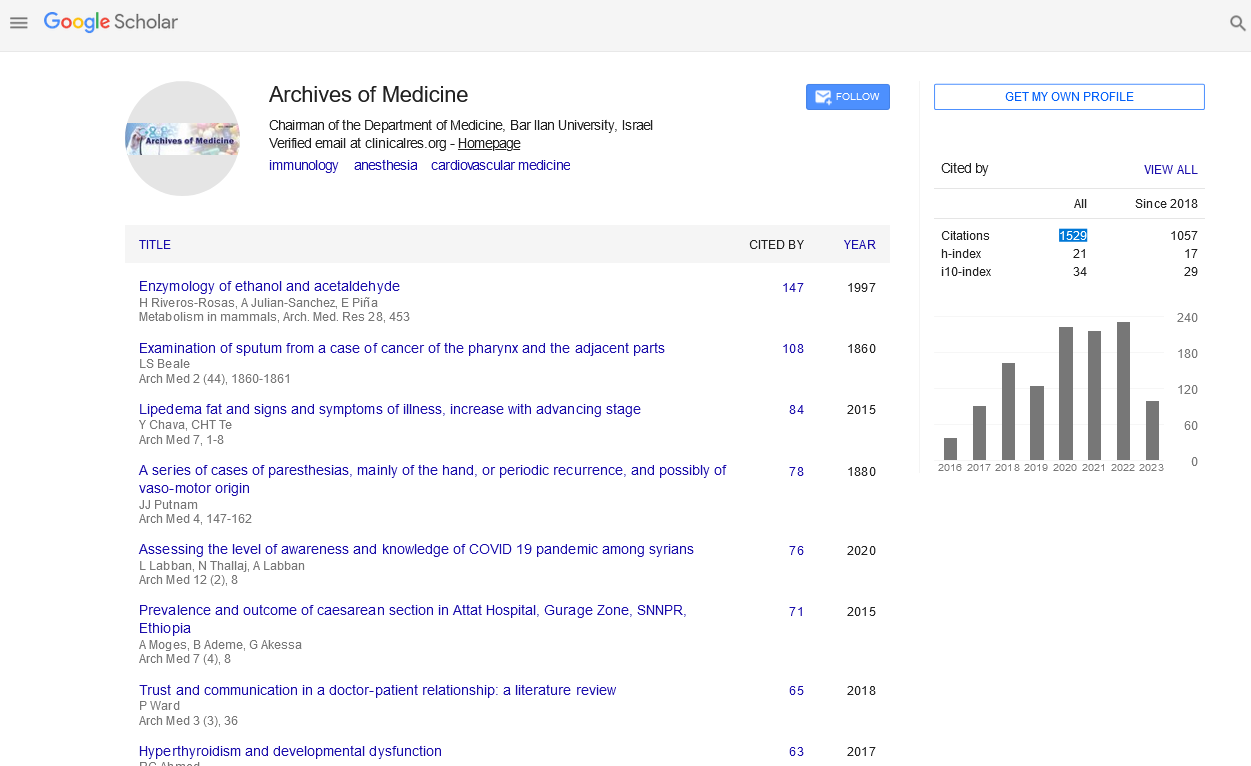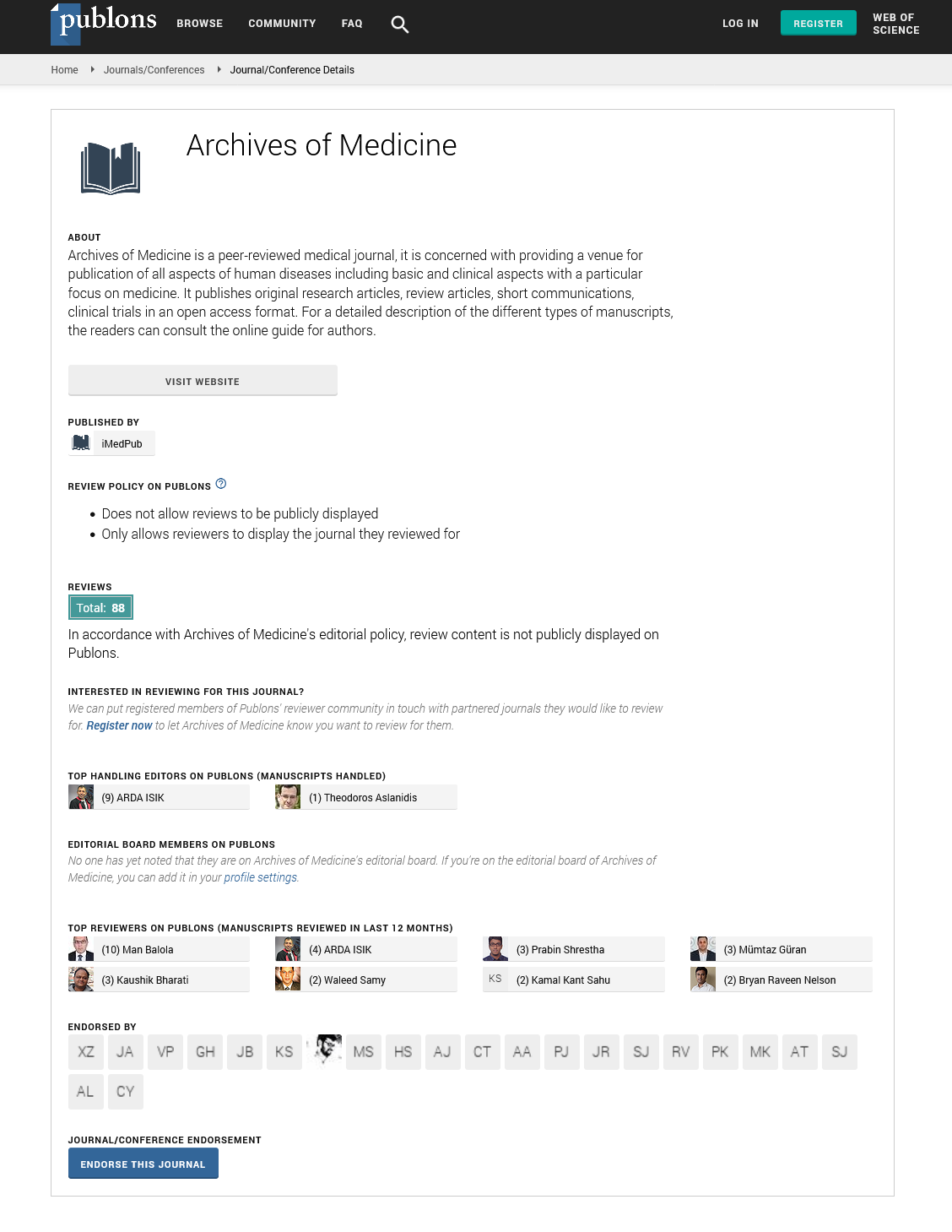Short Communication - (2024) Volume 16, Issue 1
Navigating Antiseizure Medication: A Comprehensive Guide to Treatment Options and Considerations
Alivia Kayson*
Department of Medicine, Federal University of Santa Maria, Santa Maria 97105-900, Brazil
*Correspondence:
Alivia Kayson, Department of Medicine, Federal University of Santa Maria, Santa Maria 97105-900,
Brazil,
Email:
Received: 01-Jan-2024, Manuscript No. ipaom-24-14809;
Editor assigned: 03-Jan-2024, Pre QC No. P-14809;
Reviewed: 17-Jan-2024, QC No. Q-14809;
Revised: 20-Jan-2024, Manuscript No. R-14809;
Published:
27-Jan-2024
Introduction
Epilepsy affects millions of people worldwide, making
it one of the most common neurological disorders. While
epilepsy can manifest in various forms and severity
levels, one of the primary treatment approaches involves
antiseizure medications (ASMs). ASMs play a crucial role
in managing seizures, but selecting the right medication can
be complex and requires careful consideration of multiple
factors. In this comprehensive guide, we will explore the
various treatment options available, considerations for
choosing the appropriate ASM and important factors to
keep in mind during treatment.
Description
Understanding antiseizure medications
Antiseizure medications, also known as antiepileptic
drugs (AEDs), work by stabilizing electrical activity in the
brain to prevent or reduce the occurrence of seizures. These
medications can be broadly categorized based on their
mechanisms of action, including:
Sodium channel blockers: ASMs such as
carbamazepine, phenytoin and lamotrigine exert their
effects by blocking voltage-gated sodium channels, thereby
reducing neuronal excitability.
Calcium channel blockers: Medications like
ethosuximide and valproate act by blocking calcium
channels, which play a role in neurotransmitter release and
neuronal excitability.
Gaba analogues: Gamma-aminobutyric acid (GABA)
is the primary inhibitory neurotransmitter in the brain.
ASMs such as benzodiazepines (e.g., clonazepam) and
barbiturates (e.g., phenobarbital) enhance GABAergic
transmission, thereby suppressing seizure activity [1-3].
Glutamate antagonists: Glutamate is the primary
excitatory neurotransmitter in the brain. ASMs like
topiramate and felbamate inhibit glutamate receptors,
reducing neuronal excitability.
Miscellaneous: Some ASMs, such as levetiracetam and
gabapentin, have unique mechanisms of action that may
involve modulation of neurotransmitter release or neuronal
excitability through other mechanisms.
Choosing the right antiseizure medication
Selecting the most appropriate ASM for an individual patient requires careful consideration of several factors:
Seizure type: Different ASMs may be more effective
for specific seizure types. For example, sodium channel
blockers like carbamazepine are often preferred for
focal seizures, while valproate may be more effective for
generalized seizures.
Comorbidities: Patients with epilepsy often have
comorbid conditions such as mood disorders or cognitive
impairment. Certain ASMs may exacerbate or improve
these comorbidities, so choosing a medication that
addresses both seizures and comorbidities is crucial.
Age and Gender: Age and gender can influence ASM
selection and dosing. For example, valproate is generally
avoided in women of childbearing age due to its teratogenic
effects, while certain ASMs may require dose adjustments
in the elderly population.
Drug interactions: ASMs can interact with other
medications, including contraceptives, anticoagulants and
psychiatric medications. Clinicians must consider potential
drug interactions when prescribing ASMs to avoid adverse
effects or reduced efficacy.
Side effect profile: Each ASM has a unique side
effect profile that can impact tolerability and adherence
to treatment. Common side effects include dizziness,
drowsiness, weight gain and cognitive impairment.
Choosing an ASM with a favorable side effect profile is
essential for optimizing patient outcomes.
Monitoring and adjusting treatment
Once an ASM is initiated, regular monitoring is
necessary to assess its efficacy and tolerability. This may
involve routine clinical visits, laboratory testing and seizure
frequency tracking. If seizures persist or side effects are
intolerable, adjustments to the medication regimen may be
necessary. This could include dose optimization, switching
to a different ASM, or adding adjunctive therapy [4,5].
In some cases, individuals may require combination
therapy with multiple ASMs to achieve adequate seizure
control. Combination therapy should be carefully managed
to minimize the risk of drug interactions and adverse effects
while maximizing efficacy.
Conclusion
Antiseizure medications play a central role in the
management of epilepsy, but selecting the right medication
requires careful consideration of various factors. By
understanding the mechanisms of action, considering
patient-specific factors and monitoring treatment response,
clinicians can optimize ASM therapy to achieve seizure
control while minimizing adverse effects. A collaborative
approach between patients, caregivers and healthcare
providers is essential to navigate the complexities of ASM
treatment and improve outcomes for individuals living
with epilepsy.
Acknowledgement
None.
Conflict of Interest
None.
References
- Getnet A, Woldeyohannes SM, Bekana L, et al. Antiepileptic drug nonadherence and its predictors among people with epilepsy. Behav Neurol. 2016;2016.
Google Scholar, Crossref, Indexed at
- Beydoun A, Sackellares JC, Shu V, et al. Safety and efficacy of divalproex sodium monotherapy in partial epilepsy: a double-blind, concentration-response design clinical trial. Neurol. 1997;48(1):182-8.
Google Scholar, Crossref, Indexed at
- Rossi A, Caro G, Fortuna MC, et al. Prevention and treatment of chemotherapy-induced alopecia. Dermatol Pract Concept. 2020;10(3).
Google Scholar, Crossref, Indexed at
- Moattari CR and Jafferany M. Psychological aspects of hair disorders: consideration for dermatologists, cosmetologists, aesthetic and plastic surgeons. Skin Appendage Disord. 2022;8(3):186-94.
Google Scholar, Crossref, Indexed at
- Pillans PI and Woods DJ. Drug-associated alopecia. Int J Dermatol. 1995 Mar 1;34(3).
Google Scholar, Crossref, Indexed at






